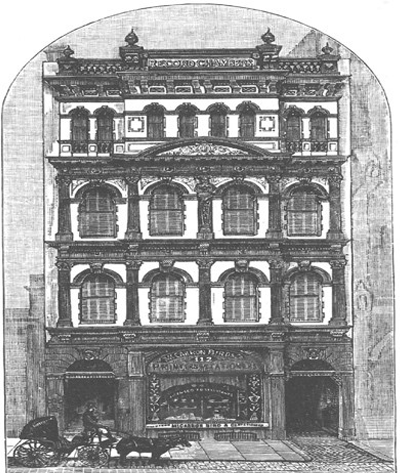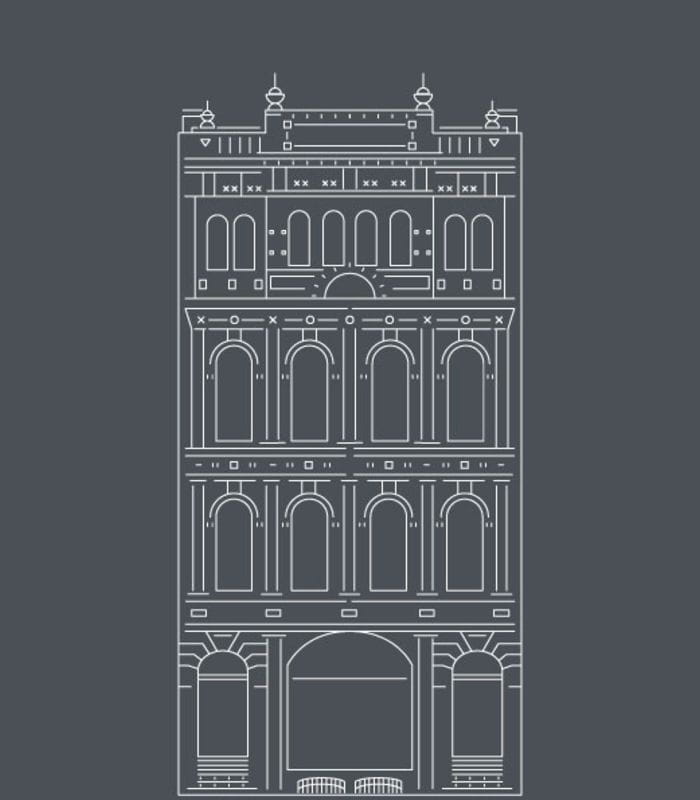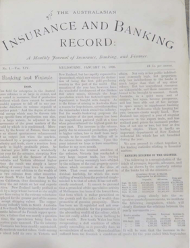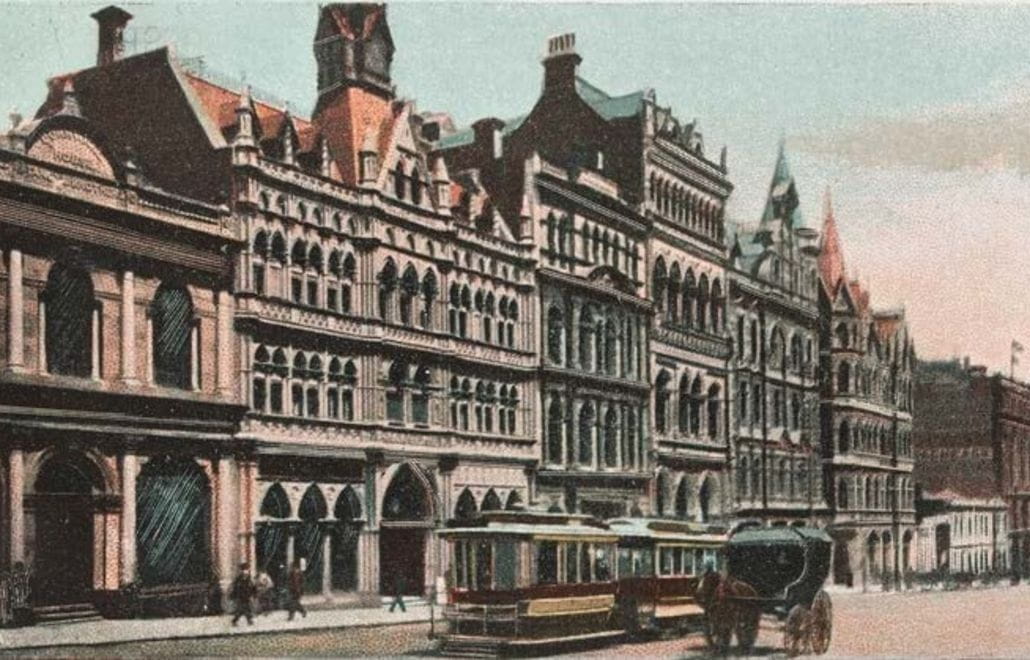Record Chambers
One of Melbourne’s largest and most prominent nineteenth century publishing companies, McCarron, Bird and Co., engaged architect J A B Koch to design an office and printing works. The result is an arresting structure with certain German Baroque motifs that reveal Koch’s German roots.
Koch was a renowned architect of the time, appointed as Architect to the City of Melbourne in 1873 and responsible for the design of several market buildings. His best known buildings include National Trust owned Labassa (originally called Ontario) (1889-1890) in Manor Grove, Caulfield North and the privately owned Friesia (1887) at 23 Isabella Grove, Hawthorn. He even served as the Mayor of Richmond from 1882 to 1883.

Image: Sketch of Record Chambers building, published soon after its completion c.1887 Source: Victoria and its Metropolis, Past and Present, Volume IIB, 1977, p.569
The Design
The Record Chambers’ façade is a manifestation of Free Classicism, with four imposing bays divided by Renaissance-style columns, and a half-female figure on a pedestal (caryatid terminus) drawing the eye to the central column on the second storey.
The name of the building is inscribed on the rooftop, framed by a bracketed cornice, balustraded parapet and four classic urns.
The Australian Builder and Contractor’s News described the building in October 1887 as being, ‘entirely new to the street architecture of this city, and the novel combination of the façade, composed as it is of carved Pyrmont yellow and Oamaru white freestone, gives the building a very elegant and impressive, as well as distinctive, appearance.’
The article praised the ‘beautifully carved capitals’ of the pilasters, the ‘handsome modillion cornice’ and a ‘pleasing feature’ in the stained glass of the main entrance.

Publishing Tenants
The Record Chambers was fittingly named after the Australasian Insurance and Banking Record, published by the owners of the building, McCarron, Bird and Co. In addition to ‘The Record’, McCarron, Bird and Co. also produced the Australian Trade Review, Australian Brewer’s Journal and the Temperance News within the walls of this significant building. Notably, tenants in the Olderfleet building also included trade publications such as the Australian Dog, Poultry Gazette and Australasian Pastoralists Review.
These trade publications were a direct reflection of the interests of the companies residing at the western end of Collins Street during this booming era of Melbourne. The Temperance News, for example, was published by the Temperance Society, whose objective was to address social issues relating to alcohol consumption in Melbourne.
The occupation of the office spaces remained focused on publishing and printing, as well as holding the offices for the building’s architect J A B Koch, an accounting firm and various investment companies.
In the Post-World War Two period, the Printing and Allied Trades Employers Federation of Australia and the Victorian Master Printers and Allied Trade Association where all tenants of the building.

Image: Advertisements from the Australasian Insurance and Banking Record. Source: State Library of Victoria
In-house Artists
German painter and lithographer, Ludwig Lang, arrived in Melbourne from Germany in 1860 and set up a studio in the Record Chambers from 1890 to 1901. He had previously worked for companies including Fergusson and Mitchell, Sands and McDougall, and the Victorian Government Printing Office. Lang was the foundation President of the Victorian Lithographic Artists and Engravers Club from 1889 to 1891.
In 1891 Lang designed a series of illuminated speeches to honour local mayors. The watercolour and ink work he created to celebrate the first Mayor of Oakleigh, Francis Walter Binns, was painted during his time at the Record Chambers and is inscribed with the address, 479 Collins Street.

Image: Illuminated address to Francis W Binns, 1891 by Ludwig Lang, inscribed ‘L. Lang, 479 Collins St Melb. Source: State Library of Victoria, pictures collection
This 1891 illuminated address to Francis W. Binns was created by lithographic artist, Ludwig Lang. The original text is written in delicate calligraphically with coloured capital letters, within an idealised bush scene behind a foreground display of native flowers, including waratahs and heaths. Below the text is a circular inset illustrating the beginnings of a settlement in cleared bush, introducing the theme of ‘progress’. The address is enclosed in a moulded frame, signed, ‘L. Lang. 479 Collins St. Melbourne’.
Size: 56.5cm × 43.0cm inside mount. The text reads:
To F. W. Binns Esq. J.P.
Mayor of Oakleigh.
Dear Sir,
We the undersigned Members of the Council of the Borough of Oakleigh at the termination of your period of Office as the first Mayor of the Borough desire to place on record in some permanent manner our warm appreciation of the manner in which you have conducted the business of the Council — and also to express our sense of the indefatigable exertions used by you in securing the formation of the Borough.
Wishing you every success in life and hoping you may long be spared to give the Borough the benefit of your Services.
We are Dear Sir,
Yours faithfully
Thomas Davey. Mayor
Henry Bishop. Town Clerk
Borough Chambers,
Oakleigh,
August, 17th 1891.

Image: A postcard showing the Western end of Collins Street, 1890s Source: State Library of Victoria
